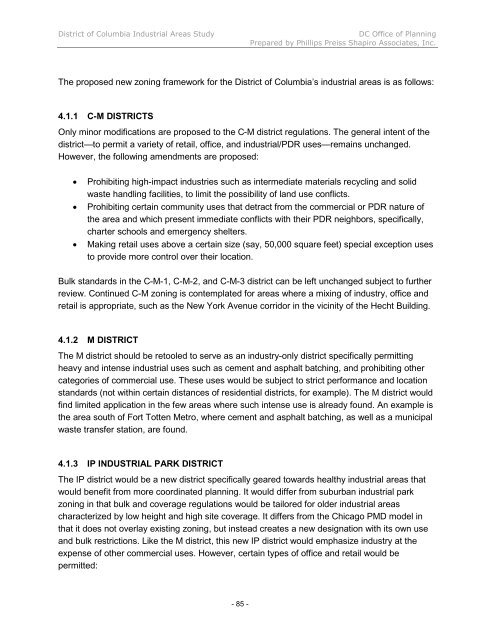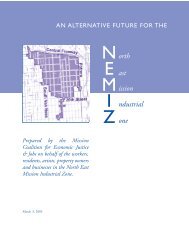INDUSTRIAL LAND IN A POST-INDUSTRIAL CITY District of ...
INDUSTRIAL LAND IN A POST-INDUSTRIAL CITY District of ...
INDUSTRIAL LAND IN A POST-INDUSTRIAL CITY District of ...
Create successful ePaper yourself
Turn your PDF publications into a flip-book with our unique Google optimized e-Paper software.
<strong>District</strong> <strong>of</strong> Columbia Industrial Areas Study DC Office <strong>of</strong> Planning<br />
Prepared by Phillips Preiss Shapiro Associates, Inc.<br />
The proposed new zoning framework for the <strong>District</strong> <strong>of</strong> Columbia’s industrial areas is as follows:<br />
4.1.1 C-M DISTRICTS<br />
Only minor modifications are proposed to the C-M district regulations. The general intent <strong>of</strong> the<br />
district—to permit a variety <strong>of</strong> retail, <strong>of</strong>fice, and industrial/PDR uses—remains unchanged.<br />
However, the following amendments are proposed:<br />
Prohibiting high-impact industries such as intermediate materials recycling and solid<br />
waste handling facilities, to limit the possibility <strong>of</strong> land use conflicts.<br />
Prohibiting certain community uses that detract from the commercial or PDR nature <strong>of</strong><br />
the area and which present immediate conflicts with their PDR neighbors, specifically,<br />
charter schools and emergency shelters.<br />
Making retail uses above a certain size (say, 50,000 square feet) special exception uses<br />
to provide more control over their location.<br />
Bulk standards in the C-M-1, C-M-2, and C-M-3 district can be left unchanged subject to further<br />
review. Continued C-M zoning is contemplated for areas where a mixing <strong>of</strong> industry, <strong>of</strong>fice and<br />
retail is appropriate, such as the New York Avenue corridor in the vicinity <strong>of</strong> the Hecht Building.<br />
4.1.2 M DISTRICT<br />
The M district should be retooled to serve as an industry-only district specifically permitting<br />
heavy and intense industrial uses such as cement and asphalt batching, and prohibiting other<br />
categories <strong>of</strong> commercial use. These uses would be subject to strict performance and location<br />
standards (not within certain distances <strong>of</strong> residential districts, for example). The M district would<br />
find limited application in the few areas where such intense use is already found. An example is<br />
the area south <strong>of</strong> Fort Totten Metro, where cement and asphalt batching, as well as a municipal<br />
waste transfer station, are found.<br />
4.1.3 IP <strong><strong>IN</strong>DUSTRIAL</strong> PARK DISTRICT<br />
The IP district would be a new district specifically geared towards healthy industrial areas that<br />
would benefit from more coordinated planning. It would differ from suburban industrial park<br />
zoning in that bulk and coverage regulations would be tailored for older industrial areas<br />
characterized by low height and high site coverage. It differs from the Chicago PMD model in<br />
that it does not overlay existing zoning, but instead creates a new designation with its own use<br />
and bulk restrictions. Like the M district, this new IP district would emphasize industry at the<br />
expense <strong>of</strong> other commercial uses. However, certain types <strong>of</strong> <strong>of</strong>fice and retail would be<br />
permitted:<br />
- 85 -












